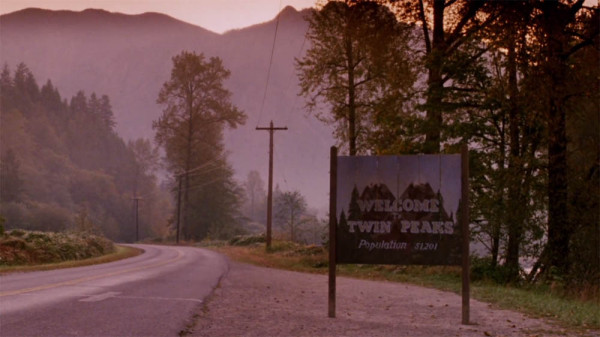Twin Peaks is back! As promised, after 25 years, the band is back together and as weird as ever.
Twin Peaks’ success, all those years ago, went a long way to shaping a lot of the television – and television fandom – we see today. The off-kilter, creepy backwoods Americana tapped into by David Lynch and the show’s writers developed a lexicon and life of its own. It ripples have resonated across a quarter of a century, and are still with us today. Its constant drive to defer resolution, leaving fascinating plot and character non-sequiturs in its wake, influenced a generation of writers, and a generation of shows that are happy to have their characters go off and have a life of their own outside of the cosy, neatly resolved bubble of their drama.
Unlike the innovations it bought with it back in 1990, though, Twin Peaks’ return to television could be passed off as merely another me-too move reflecting the trend for televisually Getting The Band Back Together. It’s a path already trodden by that other iconic genre-defining 90s show, The X-files. So, what Twin Peaks have to offer in 2017?
A World With It’s Own Rhythm
On the surface, little has changed. The haunting style and defined visual aesthetic is maintained, the largely unmoving cameras that David Lynch has placed to collect the action are perfect for the glacial pace of life in Twin Peaks, and the glacial speed of the action here. Of course, that was always the way; the calm ephemera of small town life depicted served as the backdrop for the jarring events and occult undertones of what was happening, and so it is here. Out of that ephemera, you are then left to decide for yourself what’s important and what’s not. Is it all important, or none of it?
When the screen goes dark suddenly, and strident gunshots-style beats break the stupor to reintroduce Kyle McLachlan, we’re a full 20 minutes in, and literally nothing appears to have actually happened. This makes the outbursts of violence, and there are some, all the more engaging and the build up to the almost interminable.
The movie-length first episode – actually episodes 1 & 2 tacked together for our late-night viewing pleasure – flip-flops its early action (and I use that term in loosest possible sense) between the nostalgia-infused reintroduction of Twin Peaks’ well-established, slow, rural world, and a new, seemingly even slower, urban locale. There, in a Lost-style scenario, a man performs a seemingly pointless task in almost complete isolation for reasons he doesn’t understand. The staccato style of the dialogue is mirrored between the two locales, there’s coffee, and directorial pacing is used to a similar devastating effect.
New Locations, Same Old Story
Slowly, as this new incarnation of Twin Peaks begins to move in and out of the locations we recognise, it becomes obvious that this is not going to have quite the claustrophobic, almost hermetically sealed character of the first run of the show. Though there’s little doubt the wider scope of the story is going the entwine these very different places, as it tells its twisting – and no doubt twisted – tale. Old characters weave in and out – Sheriff Hawk, a welcome return for the log lady, Lucy Moran on the switchboard – and all have their moment in spotlight, while we try to get purchase on the new characters despite the shifting sands of the dialogue.
Matthew Lillard’s school principle and his wife feature heavily in this, as we’re introduced to some new law enforcement as a new murder plot unfolds. It’s largely the same cocktail as before; a mix of ‘who’s telling the truth’, or rather ‘who’s lying about what to whom’, and ‘what the hell just happened?’ All presented with the same arthouse sensibility, in a way that – after 25 years and augmented by a dusting of nostalgia – is still deeply satisfying as well as extremely unnerving.
That was always the point, though. Like the music of The Pixies or Nirvana, Twin Peaks works because of the dynamic between its loud and the quiet, and the lasting impression that leaves. Not for this show, the constant pounding of drums underpinning the heart-pounding action as we switch between set-pieces and exposition; no, it trades in the loud/quiet grungy ying/yang of the music from the decade whence it came – and features similar mumbled, barely intelligable lyrics.
The new Twin Peaks has the same ying/yang shifts. There’s the rural and the urban; the Black Lodge’s Red Room – where a significant part of the second episode takes place, and where the what appears to be the series’ narrative drive is explained – and the physical world; the calm quotidian dialogue marking the slow passing of time, interspersed shards of violence.
Peak Condition
So, much like your feelings for the style of music I’ve compared it to, if you liked Twin Peaks then, you’ll like it now. If you hated it then… Guess what? This is a undoubtedly modern presentation of the concept – almost a soft-reboot, to use today’s parlance – but very little has changed. Frankly, that’s how I like it. This revisit is not messing around, either. Everyone – especially Kyle McLachlan – is on their A game here, and I can’t wait to see where it all goes. This is still a damn fine slice of TV, and though its ideas have been riffed on many times, you’ll still find little that really comes close to it. Frustrating, bordering on incoherent, beautiful, engaging and quite, quite brilliant in a way that’s almost impossible to pin down.
Does it make sense? No! Will it? Who can tell? Will I be watching it next week? Absolutely!

